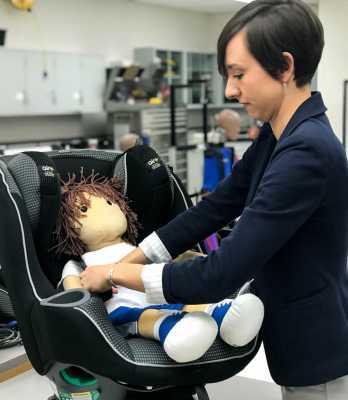03 Apr Do Rear-Facing Car Seats Protect Children From Rear Crashes?
MedicalResearch.com Interview with:

Julie Mansfield straps a doll into a car seat. Rear-facing car seats are known to protect children in front and side impact crashes, but are rarely discussed in terms of rear-impact collisions. In a new study, researchers at The Ohio State University Wexner Medical Center explored the effectiveness of rear-facing car seats in rear-impact accidents by conducting crash tests with different car seat types and features . It is important to make sure what the impact would be if someone was in a car accident. Accidents do, unfortunately, happen. If the seat you’re isn’t up to the right standards then you could be putting your child at greater risk! Regardless whether you’re in your car or in an Uber, if you find yourself needing help in the case your child seat gives way in the event of an incident with Uber then looking into a uber accident attorney is the next step. Like wise, if you’re on your own in you car, you are going to want to contact the manufacturer of the seat for further information and see if you’re entitle to compensation. Which is why it is a good idea to make sure that you have the right sort of car insurance for you and your car. You can compare car insurance here if you are unsure about what you can get.
Julie Mansfield, Lead author
Research engineer
Injury Biomechanics Research Center
Ohio State College of Medicine
MedicalResearch.com: What is the background for this study? What are the main findings?
Response: Parents and caregivers often understand that a rear-facing car seat will support the head, neck, and spine during frontal impacts. In frontal impacts, the child will simply be cradled and supported by the shell of the car seat as crash forces “pull” the child toward the front of the vehicle. However, caregivers often ask how a rear-facing car seat would work if the vehicle is struck from behind. In that case, crash forces might “pull” the occupant toward the rear of the vehicle. In this case, they wonder whether the head and neck of the rear-facing child would be supported.
Injuries to children in rear impact crashes are fairly rare. However, we wanted to run some crash tests so we could see exactly what was happening in these scenarios. With these data, we can better explain to caregivers how rear-facing car seats work in this type of crash.
We exposed four different models of rear-facing car seats to a moderate severity rear-impact crash pulse. All were installed on a recent model year vehicle seat. We used crash test dummies representing a one-year-old child and a three-year-old child.
We found that the rear-facing car seats protected the crash test dummy well when exposed to a typical rear impact. The car seats supported the child throughout the crash and still did their job to keep the head, neck, and spine aligned. A lot of the crash energy was absorbed through the car seat interacting with the vehicle seat, so that reduced the amount of energy transferred into the occupant. This is important in preventing injuries.
MedicalResearch.com: What should readers take away from your report?
Response: Best practice recommendations from the American Academy of Pediatrics already suggest that parents use rear-facing car seats until at least age two, or preferably longer if possible. Our findings help support these recommendations because we did not see any major issues with the rear-facing car seats in the crash scenario that we studied.
Children will always get the best benefit of a car seat when it is properly installed and used correctly on every trip. We recommend that parents attend a car seat check, where a certified professional will provide hands-on guidance for proper use of their seat. These are usually free and parents can look up local resources at https://www.nhtsa.gov/equipment/car-seats-and-booster-seats#install-inspection.
MedicalResearch.com: What recommendations do you have for future research as a result of this work?
Response: Future research might focus on a larger variety of child seat models or vehicle seat models, because we could only look at a limited sample in our study. Also, physical testing can only tell us how crash test dummies react to crash forces—they are not perfect representatives of actual children. Thus, it is also useful to look at crash databases and examine what types of injuries occurred to real children in real crashes. These types of data help us understand how car seats perform in realistic scenarios, and also show researchers which topics have the greatest need for attention and improvement.
MedicalResearch.com: Is there anything else you would like to add?
Response: The authors would like to acknowledge the National Science Foundation (NSF) Center for Child Injury Prevention Studies at the Children’s Hospital of Philadelphia (CHOP) and the Ohio State University (OSU) for sponsoring this study and its Industry Advisory Board (IAB) members for their support, valuable input and advice. The views presented are those of the authors and not necessarily the views of CHOP, OSU, the NSF, or the IAB members.
Citations:
Study: Are Rear-Facing Car Seats Safe In Rear-End Crashes?
Front and side impacts have been extensively researched, but rear-impacts are rarely studied
[wysija_form id=”3″]
The information on MedicalResearch.com is provided for educational purposes only, and is in no way intended to diagnose, cure, or treat any medical or other condition. Always seek the advice of your physician or other qualified health and ask your doctor any questions you may have regarding a medical condition. In addition to all other limitations and disclaimers in this agreement, service provider and its third party providers disclaim any liability or loss in connection with the content provided on this website.
Last Updated on April 3, 2018 by Marie Benz MD FAAD
